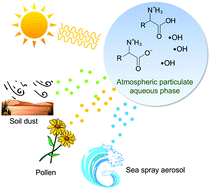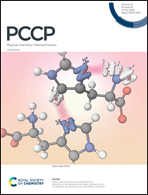T- and pH-dependent OH radical reaction kinetics with glycine, alanine, serine, and threonine in the aqueous phase†
Abstract
Glycine, alanine, serine, and threonine are essential amino acids originating from biological activities. These substances can be emitted into the atmosphere directly. In the present study, the aqueous phase reaction kinetics of hydroxyl radicals (˙OH) with the four amino acids is investigated using the competition kinetics method under controlled temperature and pH conditions. The following T-dependent Arrhenius expressions are derived for the ˙OH reactions with glycine, k(T, H2A+) = (9.1 ± 0.3) × 109 × exp[(–2360 ± 230 K)/T], k(T, HA±) = (1.3 ± 0.1) × 1010 × exp[(–2040 ± 240 K)/T]; alanine, k(T, H2A+) = (1.4 ± 0.1) × 109 × exp[(–1120 ± 320 K)/T], k(T, HA±) = (5.5 ± 0.2) × 109 × exp[(–1300 ± 200 K)/T]; serine, k(T, H2A+) = (1.1 ± 0.1) × 109 × exp[(–470 ± 150 K)/T], k(T, HA±) = (3.9 ± 0.1) × 109 × exp[(–720 ± 130 K)/T]; and threonine, k(T, H2A+) = (5.0 ± 0.1) × 1010 × exp[(–1500 ± 100 K)/T], k(T, HA±) = (3.3 ± 0.1) × 1010 × exp[(–1320 ± 90 K)/T] (in units of L mol−1 s−1). The energy barriers of the ˙OH-induced H atom abstractions were simulated by the density functional theory (DFT) calculation performed with GAUSSIAN using the method of M06-2X and the basis set of 6-311++G(3df,2p). According to the calculation results, the –COOH and –NH3+ groups with strong negative inductive effects increase the energy barriers and thus decrease the ˙OH reaction rate constants. In contrast, the presence of a –OH or –CH3 group with weak negative or positive inductive effects can reduce energy barriers and hence increase the ˙OH reaction rate constants. To improve the previous structure–activity relationship, the contribution factors of –NH3+ at Cα-atom and Cβ-atom are determined as 0.07 and 0.15, respectively. Aqueous phase ˙OH oxidation acts as an important sink of the amino acids in the atmosphere, and can be accurately described by the obtained Arrhenius expressions under atmospheric conditions.



 Please wait while we load your content...
Please wait while we load your content...